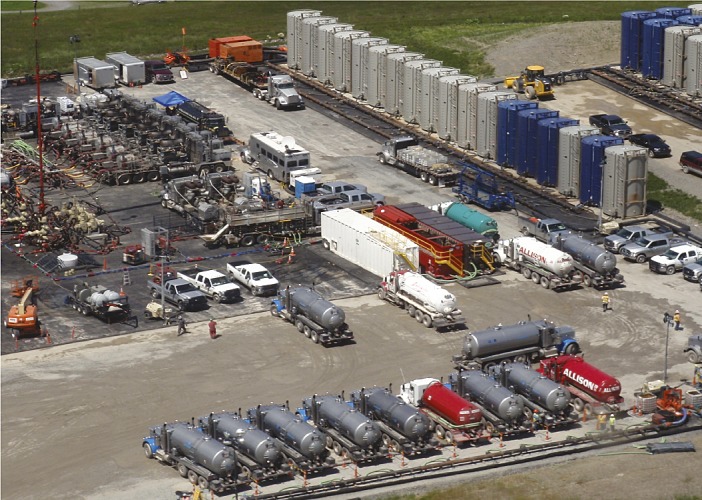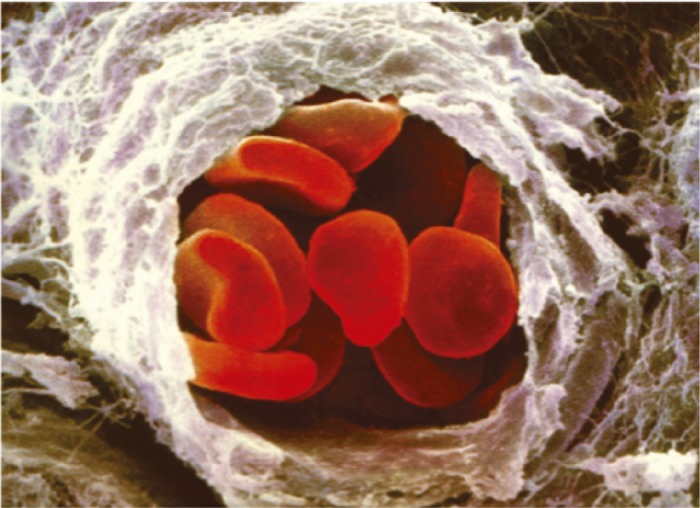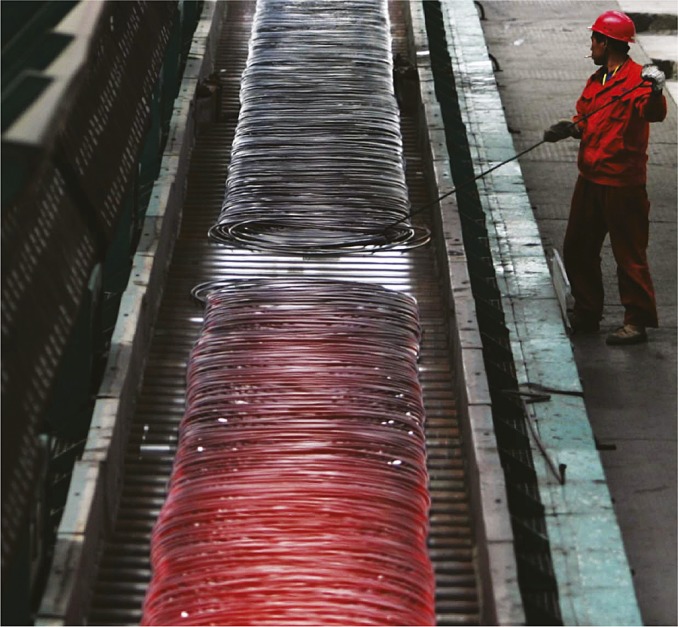Drinking water quality near Marcellus shale gas extraction sites

Marcellus shale gas extraction well pad in Pennsylvania.
Shale gas comprises an increasing fraction of the US natural gas supply, but the environmental implications of shale gas extraction—a process that includes horizontal drilling and hydraulic fracturing—remain uncertain. Expanding their previous study of methane gas contamination in private drinking water wells near active drilling operations in the Marcellus shale region of northeastern Pennsylvania and southeastern New York, Robert Jackson et al. (pp. 11250–11255) analyzed the concentrations and isotopic signatures of methane, ethane, and propane in 141 wells in the area. The authors report that 82% of the wells analyzed contained methane; on average, methane concentrations were six times higher for homes located less than 1 km from drilling sites than for homes farther away. Concentrations of ethane and propane were also high for homes located within 1 km of drilling sites. Furthermore, the authors found that distance to gas wells was the most significant factor to influence drinking water methane and ethane concentrations. In some cases, the authors report, the isotopic signatures and relative proportions of the gases in drinking water were characteristic of a Marcellus-like source. The findings suggest that some homes located within 1 km of Marcellus gas wells might have drinking water contaminated with stray gases, according to the authors. — N.Z.
Images of home disrupt nonnative language processing
Studies of biculturalism have found that culturally evocative visual stimuli can subconsciously trigger characteristic cognitive patterns of that culture, and shift how bicultural individuals navigate social situations. For example, a Chinese restaurant may evoke native cultural themes and scripts in a Chinese immigrant, inducing the individual to socialize and make decisions according to Chinese norms. Shu Zhang et al. (pp. 11272–11277) investigated whether visual cues can automatically activate native language structures that interfere with second-language processing. The authors found that for Chinese immigrants in the United States, addressing an individual with a Chinese face increased social comfort but reduced English fluency, effects that were not observed in a control group of European Americans. Similarly, viewing images of the Great Wall and other icons of Chinese culture acted as a kind of “cultural priming” that hindered English fluency in Chinese immigrants. The authors also report that cultural priming increased Chinese immigrants’ tendency to describe pictures with literal translations from the Chinese language, such as identifying pistachios as “happy nuts,” a telltale sign of Chinese lexical structures intruding into English language processing. According to the authors, the findings have implications for cultural psychology and can help with understanding how immigrants gain fluency in new cultures and languages. — T.J.
Nitric oxide bioactivity and oxygen delivery following blood transfusions

Red blood cells release vasodilatory S-nitrosothiol-based (S-NO) bioactivity to optimize tissue oxygenation.
Red blood cell transfusion is a common medical intervention designed to maintain or improve oxygen delivery to tissues, but transfusions are not well established to improve tissue oxygenation and may even increase the risk of adverse cardiac events, renal failure, and death. Recent evidence indicates that donated red blood cells rapidly lose nitric oxide—a chemical messenger carried by hemoglobin in the form of an S-nitrosothiol that dilates blood vessels—thereby compromising the cells’ ability to deliver oxygen to tissues. James Reynolds et al. (pp. 11529–11534) investigated whether restoration of S-nitrosohemoglobin (SNO-Hb) levels in red blood cells prior to transfusion, a process called renitrosylation, improves tissue blood flow and oxygen delivery. The authors found that transfusion with red blood cells deficient in SNO-Hb decreased oxygen levels in the skeletal muscle of mice, whereas transfusion with renitrosylated cells maintained normal oxygen levels. Furthermore, in anemic rats or sheep, the authors found that blood flow, tissue oxygenation, and kidney function were improved in animals that received renitrosylated red blood cells compared with those that received transfusions of cells deficient in SNO-Hb. The findings suggest that renitrosylation of banked blood may be a potentially promising strategy to improve oxygen delivery to tissues following blood transfusion, and to reduce transfusion-related morbidity and mortality, according to the authors. — N.Z.
Mothers’ gastrointestinal bypass surgery linked to children’s heart health
Previous studies have found lower prevalence of obesity, less adiposity, less hypertension, and greater insulin sensitivity in children born to women who underwent gastrointestinal bypass surgery for weight loss compared with siblings born before the surgery. To test the effects of the surgery on genetic markers of heart health in the offspring, Frédéric Guénard et al. (pp. 11439–11444) recruited 20 unrelated 35–51-year-old mothers residing in and around Québec City who had undergone a type of gastrointestinal bypass surgery called biliopancreatic diversion with duodenal switch to treat severe obesity. The authors performed gene expression analysis on a cohort of 25 offspring born before the mothers underwent the surgery and 25 siblings born after the surgery; the offspring varied in age from 2–25 years. The authors found that 5,698 genes, notably those involved in inflammation, vascular disease, and the control of glucose metabolism, were differentially methylated between the two sibling groups; methylation is a chemical modification known to influence gene expression. Further, the authors observed correlations between gene methylation levels and the functions of genes implicated in cardiovascular disease and diabetes, suggesting potential mechanisms underlying metabolic improvements previously reported in offspring born after the surgery. The authors suggest that differences in gene methylation might partly explain the improved markers of cardiovascular health observed in children born to mothers after gastrointestinal bypass surgery. According to the authors, the findings suggest links between a maternal surgical intervention, changes in the uterine environment, and offspring gene expression. — P.N.
A retrovirus subtype isolated from zoo koalas may be associated with malignant disease
Leukemia and lymphoma account for over 60% of deaths in captive koalas in northeastern Australia, and a gammaretrovirus, KoRV, has been previously isolated from these koalas. Wenqin Xu et al. (pp. 11547–11552) investigated the genetic diversity of KoRV isolates among 28 koalas from the San Diego Zoo (SDZ) maintained for over 45 years with limited outbreeding and 13 koalas from the Los Angeles Zoo (LAZ) maintained by continuously assimilating captive-born Australian koalas. SDZ koalas were free of malignant disease, and were infected only with the endogenous KoRV, termed subtype A. Six of 13 LAZ koalas, including three that died of lymphoid leukemias, were infected not only with KoRV-A but also a highly related but distinct KoRV that the authors termed KoRV-B. KoRV-B was most divergent from KoRV-A in its envelope protein, and contained duplicated enhancer regions in its long-terminal repeats—areas of repeated DNA associated with gene regulation and increased pathology in gammaretroviruses. KoRV-A and KoRV-B employ distinct receptors to infect cells, and KoRV-B was transmitted in utero from dam to offspring through de novo infection, rather than via genetic inheritance like KoRV-A. Despite the small sample size, the correlation between KoRV-B infection and lymphoid leukemias suggests that screening for KoRV-B could help determine susceptibility to malignant disease in captive koala populations, according to the authors. — S.R.
China’s CO2 divide

Steelworker on the production line at Chengde Steel Plant in Hebei Province, China. ©iStockphoto.com/EdStock.
Under the aegis of the 2009 United Nations Copenhagen Climate Change Conference, Chinese officials committed to reducing carbon dioxide emissions per unit of GDP by 40–45% of the country’s 2005 levels by 2020, but China’s emissions reduction targets are more stringent in its affluent coastal provinces than in the country’s less developed interior. Kuishuang Feng et al. (pp. 11654–11659) used a modeling method and data from China’s National Statistics Bureau to track and analyze 2007 CO2 emissions tied to products traded within China and to exports across 57 industry sectors, 26 Chinese provinces, 4 Chinese urban regions, and 107 countries. The authors report that up to 80% of the emissions related to goods consumed in developed coastal areas—such as Beijing, Tianjin, Shanghai, and Guangdong—are due to import from less-developed central and western provinces. Further, the authors report that 40% of emissions tied to exports from the coastal regions originated in central, northern, and western China where inefficient technologies and carbon-intensive manufacturing are common. Unless the emissions tied to traded goods are factored into China’s climate policies, the authors suggest that ambitious emissions reduction targets in coastal provinces might spur continued outsourcing of energy- and carbon-intensive manufacturing to the interior. According to the authors, climate policies must include consumption-based inventories for equitable management of CO2 emissions. — P.N.


